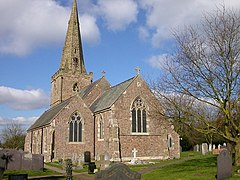Powerflush nearby to Gilmorton
 Gilmorton is a village and civil parish in Leicestershire, England, about 3 miles (5 kilometres) northeast of Lutterworth. The parish population was 976 according to the 2011 Census.
Gilmorton is a village and civil parish in Leicestershire, England, about 3 miles (5 kilometres) northeast of Lutterworth. The parish population was 976 according to the 2011 Census.
View this for powerflushing service in these postcode areas:
HISTORY
Manor
The village is mentioned in the Domesday Book of 1086, when its population was around 140 people. The toponym may be derived from the Old English words gilden (or gylden), which means “golden,” and morton, which means “town on the moor.”
Roger de Martivall was granted permission in 1303 to alienate land and property in Noseley, Gilmorton, and Stretton in order to provide an income for four chaplains at a chantry chapel in Noseley.
The parish church
All Saints Church of England parish church has a 14th and 15th-century tower, but it and its spire were rebuilt in 1909. In 1860–61, the nave, aisles, and chancel were rebuilt, and in 1897, the south porch was built. Burlison and Grylls created the stained glass for the chancel’s east window in 1878. In 1896, Shrigley and Hunt created the stained glass for the Lady Chapel. Between 1884 and 1906, Kempe and Kempe created all of the church’s stained glass. All Saints’ Church is a Grade II* listed structure.
The west tower has an eight-bell ring. The sixth bell was cast in 1738 by Thomas I Eayre of Kettering, and the tenor in 1749 by Thomas I Eayre of Kettering. In 1766, Joseph Eayre of St Neots, Huntingdonshire, cast the fourth bell. The seventh bell was cast in 1861 by John Taylor & Co of Loughborough, the fifth bell in 1871 by John Taylor & Co of Loughborough, and the treble, second, and third bells were cast in 1909 when the tower was rebuilt.
History of the economy and society
In 1777, the House of Lords debated the Gilmorton inclosure act.
Gilmorton’s tower mill was built in the early nineteenth century. The brick tower has been restored, but neither the cap nor any of the machinery has survived.
The Great Central Main Line, which ran from Nottingham Victoria south to London Marylebone, was built through Gilmorton parish in the 1890s, passing 14 miles (2 kilometres) west of the village. It opened in 1899, with the nearest station being Ashby Magna, which is 2+12 miles (4 km) northwest of the village, and Lutterworth railway station, which is slightly further to the southwest.
RAF Bruntingthorpe was established just east of the parish in 1942. Its main runway was extended by 4,800 feet (1,500 metres) in 1953, bringing it into Gilmorton parish and within 14 miles (400 metres) of the village. The air station was decommissioned in 1962, sold to the public in 1965, and is now known as Bruntingthorpe Aerodrome.
The M1 motorway extension from Crick in Northamptonshire to Leeds was built parallel to and just east of the Great Central Main Line, beginning in 1965 and finishing in 1968. The Reshaping of British Railways report from 1963 recommended that British Railways close the line, which they did in 1969.

